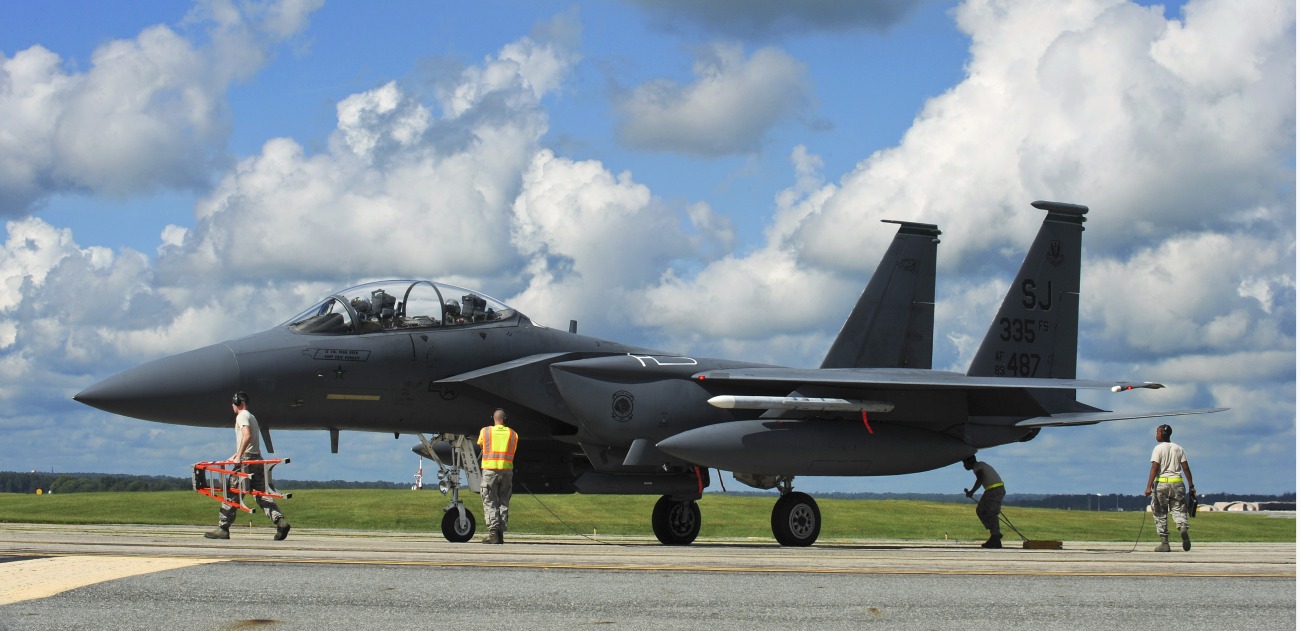As small drones continue to threaten the safety of fighter jets at US air bases, officials at Seymour Johnson Air Force Base in North Carolina are exploring the possibility of erecting physical barriers to deal with the growing menace.
To combat the threat posed by small drones, the US Air Force’s 4th Contracting Squadron sent out a Requests for Information (RFI) regarding possible choices for the “Counter Small Unmanned Aerial System Barrier.” However, the notice carried a caveat: “It does not constitute a commitment by the government.”
The concept of an anti-drone barrier emphasizes the threat that drones currently pose to American personnel serving abroad as well as to military installations inside the United States. It may also be a glaring example of how the US is making concerted attempts at finding ways to counter small drones.
The US Air Force’s F-15E Strike Eagles are located at two different facilities, including the one in North Carolina that has issued the RFI. The aircraft recently made headlines as it was lauded for shooting down about 70 drones in the Middle East. Many of these jets flew out for their assigned mission from Seymour Johnson’s 335th Fighter Squadron.
The F-15E is a capable fighter jet with an unbeaten combat record. It has been deployed worldwide in different battle zones with success. Yet, the aircraft faces a threat from small unmanned aerial vehicles (UAVs). Ironically, the fighter jet with a stellar combat record in the air remains vulnerable while parked in hangars at a United States airbase.
The RFI comes days after the German Police announced that a Eurofighter Typhoon jet rammed into a drone at the Manching Air Base last week. The drone was not authorized to be at the airport and caused some damage to the aircraft. Several such incidents have also been reported inside the United States, especially in the air, where fighters have collided with drones flying in their way.

However, the US officials at Seymour appear to be worried about drones attacking jets at the base. The officials, however, have not announced any drone incidents at Seymour Johnson that prompted the need for the barrier. Drone incursions over and around vital civilian infrastructure, including military bases and training areas, are routinely reported.
Several US officials have expressed concerns about the threat posed by these small drones. For instance, Kenneth McKenzie, who helmed the CENTCOM (the United States Central Command) earlier, said that the spread of small, cheap drones was the “most concerning tactical development” and emphasized that the dangers were exacerbated without a credible defense against the menace.
“I’m not just talking about large unmanned platforms, which are the size of a conventional fighter jet that we can see and deal with by normal air defense means. I’m talking about ones you can go out and buy at Costco right now for $1,000,” McKenzie said.
The US military has partnered with C-UAS (Counter-Unmanned Aircraft Systems) businesses to develop and implement technologies to identify, monitor, and deactivate unlicensed drones. However, erecting physical barriers appears to be a more ad hoc and intriguing solution.
⚡️🇺🇦🇷🇺 Ukrainians released footage of the drone attack on the Pskov airfield that destroyed 2 Il-76 military transport aircraft 3 days ago pic.twitter.com/UPNQ9V1ipL
— What the media hides. (@narrative_hole) September 1, 2023
The drone barrier is also interesting as it comes against the backdrop of a protracted war in Ukraine, which has witnessed drone attacks on airfields that have led to significant damage to sophisticated fighters. Both Russia and Ukraine have deployed small, cheap First Person View (FPV) drones modified to carry explosives.
Due to their small size, these FPVs fly into airfields without being detected and ram into the intended target for a kamikaze attack. Several such incidents have been reported over the months from both sides of the combat.
What Kind Of A Barrier Does Seymour Want?
The notice begins: “Problem Statement: Small Unmanned Aerial Systems (s-UAS) disrupt airfield operations, and agencies have limited response capabilities due to restrictions on countermeasures posed by the Federal Aviation Administration (Section 130i, Title 10, USC).”
The notice mentions its requirement: Commercial, off-the-shelf materials to construct a passive barrier that will keep a Group 1 or Group 2 sUAS from coming into direct contact with an F-15E Strike Eagle.
The US military classifies unmanned aircraft systems (UAS) into five categories based on their maximum weight, operational altitude, and top speed. Drones in Group 1 can weigh up to 20 pounds, travel up to 1,200 feet in the air, and accelerate to 100 knots, whereas drones in Group 2 weigh between 21 and 55 pounds and have a maximum altitude of 3,500 feet and a maximum speed of 250 knots.

The proposed anti-drone barriers at Seymour Johnson should be strong enough to stop a 55-pound drone traveling at 125 mph (about 109 knots) and to have no more than six inches of space or holes in their material or design.
The demands are specific, especially since the bases already have primary physical protection against hostile aerial assets like the canvas. In fact, the RFI specifically mentions the canvas.
So, uncertainty surrounds the precise placement of the barriers. But WarZone also points out that basic canvas covers for flight line shelters already exist. This means that the barrier would add to their protection.
The RFI notes that the “weight of material should be kept to a minimum to reduce structural load and facilitate rapid, open/closing” and that the barriers must be flame retardant no matter what material they are constructed of. Its “system [also] needs to be tightly secured in both open and closed positions.”
- Contact the author at sakshi.tiwari9555 (at) gmail.com
- Follow EurAsian Times on Google News




